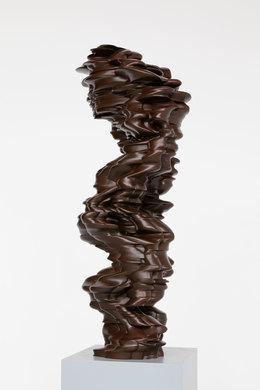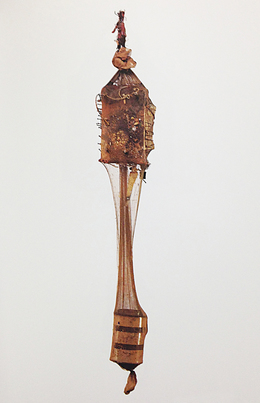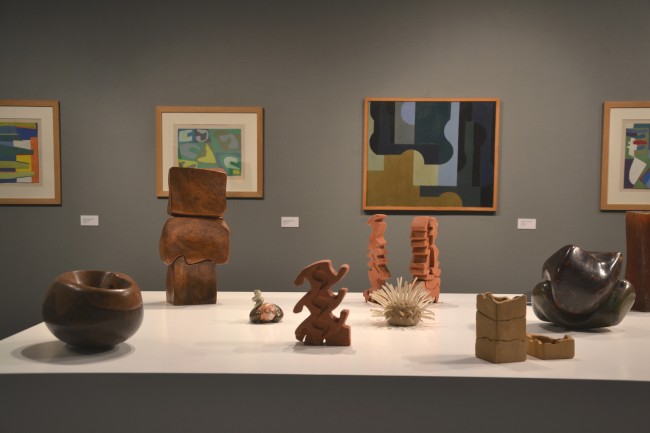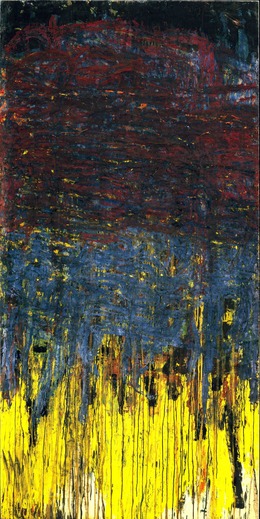In the midst of the tornado that is Armory Art Fair week, it’s always a relief to step away from the storm and visit The Art Show organized by the Art Dealers Association of America. With a 27-year history, this members-only exhibition boasts a roster of formidable galleries, with quality rather than quantity ruling the day. Ranging from blue chip to rediscovered historical masters to younger contemporary artists, ADAA is the calm, selective, eye of the cyclone. It continues to be a powerful exhibition, full of surprises.
Four painted ceramics by the French artist Fernand Léger were on display at Jeffrey H. Loria & Co., Inc. Léger is best known for his cubist imagery of industrial and cosmopolitan scenes. But in the 1950s, during the last years of his life, he created polychrome mosaic ceramics in bold colors. These pieces eschew his robotic and mechanical constructions in favor of natural and human imagery.
.
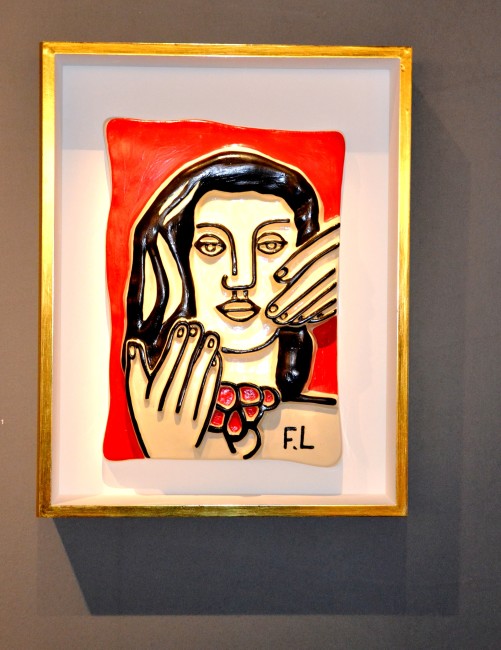
"Visage aux Deux Mains Fond Rouge" by Fernand Leger, 1953-54. Ceramic with painted polychrome, 18 1/8 x 12 3/4 inches. Original Edition No. 12.
.
Next-door, the booth at Marian Goodman Gallery is devoted to a solo exhibition of British artist Tony Cragg. Cragg’s early work of the 1980s often incorporated found objects and discarded materials grouped by color families in his site-specific installations. By the 1990s, Cragg had begun to explore sculptures derived from profiles.
Fusing figuration with abstraction, Cragg focused on capturing movement. Contorting and twisting the contoured lines of the human face, these contemporary large bronze, steel or wood sculptures take on a malleable and supple appearance.
.
.
.
A little gem by kinetic artist Yaacov Agam was on view at Adler & Conkright. The Israeli Agam was one of the artists who helped pioneer a form of art based on movement and change in the 1960s.
Integrating the formal with the mystical, Agam’s sculptures are optical wonders. He sought to create art that transcended the visual and that was a co-creation with the viewer. Suspended by a thin thread, Agam’s 10 Compositions Contrepoint is not much bigger than the palm of a hand. Spinning and shifting, this magical piece reveals multiple constructivist configurations with each rotation.
.
.
Further on, a startling series of collages by the German artist Marcel Odenbach graced the walls of Anton Kern Gallery. Odenbach’s work, constructed of tiny cut images culled from archives of press clippings and photographs, is about tension.
Seen from a distance his collages appear as vistas or objects. Up close, the material reveals tangled webs of new items that symbolize dark sociopolitical narratives. Mining the veins of memory, Odenbach is interested in the layers of history, in what is interpreted from a distance and what is understood from within.
.
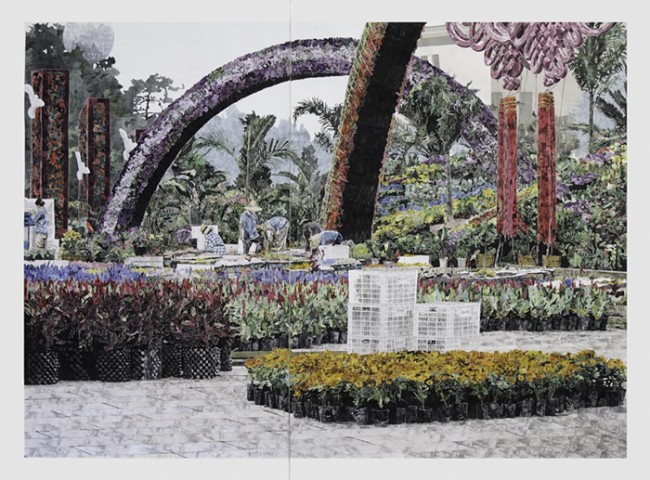
"08.08.08 (China Collage)" by Marcel Odenbach, 2008. Ink and collage on paper, 77 1/8 x 106 1/4 inches. (8074)
.

"Es läuft und läuft und läuft" by Marcel Odenbach, 2015. Ink and collage on paper, 83 3/8 x 46 3/4 inches (framed), 78 3/4 x 43 1/4 inches (paper). (ak#11117)
.
Since the 1970s, artist Haim Steinbach has focused on the selection and arrangement of everyday objects: globes, pipe-fittings and rubber chew toys. At Tanya Bonakdar Gallery, Steinbach has erected panels and screens, creating a more private environment for his sculptures.
Like many artists in the second half of the 20th century, Steinbach took his cue from Marcel Duchamp’s famous readymades: commonplace appliances like the famous urinal, Fountain, which with a swift change of venue and title, Duchamp elevated to art. But Steinbach is interested in portraying not just the whimsy of common objects, but the sinister quality of a consumerist culture.
.
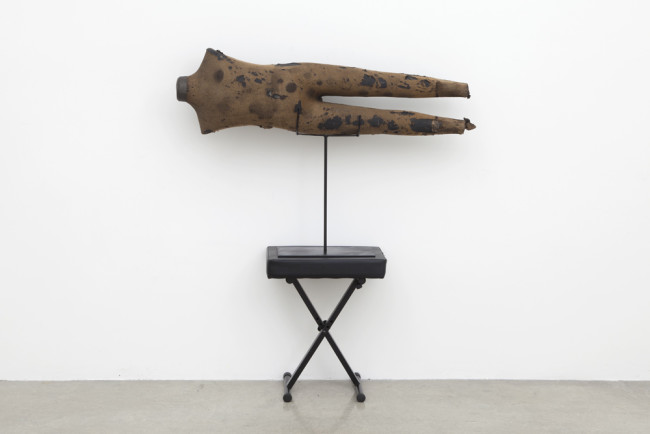
"swimmer" by Haim Steinbach, 2015. Metal, artificial leather, plastic and rubber keyboard bench, cotton cloth, and painted mannequin and metal stand, 48 3/4 x 45 1/2 x 12 1/2 inches.
.
Bruce Conner also integrated abandoned and discarded objects into his work. An early assemblage artist, in the late 1950s Conner began to rummage through thrift stores and garbage cans, which offered him cheap or even free material.
Discarded and ripped nylons were a favorite source. They were packages, skins into which he could stuff his detritus. Sheer and textured, they gave his assemblages a sexy, unsettled aura. At the Kohn Gallery, an eerie piece, Rat Purse (1959), hangs on the wall by its nylon noose.
The dense and intricate quality of Conner’s work mirrors the mysterious and complex nature of the artist himself. Famously reticent about the meaning of his work, or even showing it, Conner will be having a major retrospective at MoMA in October 2016. The show will then travel and inaugurate the new, expanded SFMoMA. Perhaps then the riddle of Bruce Conner—collagist, filmmaker (Dennis Hopper once confessed that Conner’s slicing and dicing editing style influenced the classic film “Easy Rider”) photographer, printmaker and sculptor—will be better understood.
.
.
A wonderful discovery at ADAA this year was the first solo exhibit of Lebanese artist Saloua Raouda Choucair at CRG Gallery. Born in Lebanon in 1916, Choucair attended the Ecole des Beaux Arts where she studied with Fernand Léger. Her work, seen at ADAA for the first time, reflects a deep interest in architecture, in how shapes fit together and inform one another and the whole. Often humorous, Choucair’s work incorporates a gorgeous symmetry and pattern making influenced by the Islamic designs of her Middle Eastern heritage.
.
.
A series of early totemic, large-scale abstractions by Al Held are on view at Cheim & Read. Done on butcher paper and mounted on canvas, these works form the early ’50s show the artist confronting the legacy of the older AbEx generation—Pollock, Rothko, Kline, Still, de Kooning and Newman.
These pieces are bold, full of forceful gesture and motion. Held would move on to create flatter forms of geometric abstraction, but these early achievements capture the scrambled urgency of a young Held struggling to find his own pictorial language.
.
.
.
With modest booths and highly seasoned, curated exhibitions, ADAA provides a sense of intimacy that the larger, younger fairs still lack. It’s the place where the overwhelming cacophony of Armory week finally coalesces.
BASIC FACTS: “The Art Show, Art Dealers Association of America, March 4 to 8, 2015, at the Park Avenue Armory, Park Avenue at 67th Street, New York, NY. www.artdealers.org.

